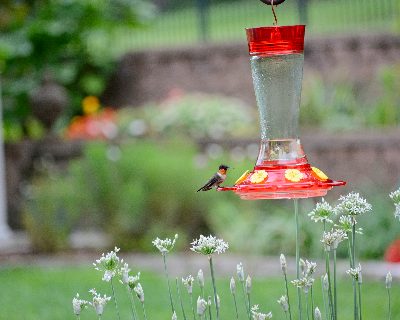Have you ever wondered what exactly is in hummingbird food and why it’s so important for these tiny birds? If you want to attract hummingbirds to your garden or keep them healthy, knowing what goes into their food is key.
The right mix not only gives them energy but also keeps them safe from harm. Keep reading, and you’ll discover the simple ingredients you can use to make hummingbird food that your feathered visitors will love. This knowledge will help you create a safe and inviting space for hummingbirds right outside your window.

Credit: www.countryliving.com
Natural Diet Of Hummingbirds
Hummingbirds eat mostly nectar from flowers. This nectar is a sweet liquid full of sugar. It gives them the energythey need to fly fast and hover.
Besides nectar, hummingbirds also eat tiny insects and spiders. These provide protein and nutrientsimportant for their health. They catch these small bugs while flying or from leaves.
Flowers with tubular shapes are best for hummingbirds. Their long beaks reach deep inside to get nectar. Bright colors like red and orange attract them the most.
Key Ingredients In Hummingbird Food
Hummingbird food mainly contains sugar and water. The usual mix is four parts water to one part sugar. This ratio is safe and healthy for hummingbirds.
Do not use honey, artificial sweeteners, or food coloring. These can harm the birds. Plain white granulated sugar is best.
Boiling the water first helps to dissolve sugar better and kills germs. After boiling, let the mixture cool before filling feeders.
Keep the food fresh. Change it every few days to avoid mold. Clean feeders regularly to keep birds safe.
Homemade Nectar Recipes
Mix 4 parts waterwith 1 part white sugar. Stir until sugar dissolves completely. Boil the mixture for 1-2 minutes to kill bacteria. Let it cool before use.
Do not use honey, brown sugar, or artificial sweeteners. These can harm hummingbirds. Use only plain white granulated sugarfor safety.
- Use clean feeders to prevent mold and bacteria.
- Change nectar every 3-4 days, more in hot weather.
- Keep feeders shaded to slow fermentation.

Credit: www.facebook.com
Avoiding Harmful Additives
Many hummingbird foods contain additives. These can be harmful. Artificial dyes are often present. They make food look pretty. But, they can hurt birds. Preservatives are another concern. They keep food fresh longer. However, they might not be safe for birds.
Choose natural ingredients instead. Sugar and water are best. This simple mix is safe. Avoid honey or brown sugar. They can cause health issues. Natural food keeps hummingbirds healthy.
Read labels carefully. Look for pure ingredients. Avoid food with unknown chemicals. It’s better for the birds. Safe food helps them thrive. Keep their food pure and simple.
Nutritional Benefits For Hummingbirds
Hummingbird food is mainly made of sugar and water. This mix gives birds the energythey need for flying and staying active. It mimics the natural nectar from flowers, which is their favorite food.
Besides sugar, hummingbirds get small amounts of minerals and vitaminsfrom natural flower nectar. These help keep them healthy and strong. The right food helps with their growth, energy, and survival.
It is important to use pure white sugarand avoid honey or artificial sweeteners. These can harm the birds. The usual recipe is one part sugar to four parts water, boiled and cooled before use.
Choosing Commercial Hummingbird Food
Commercial hummingbird food mostly contains sugar and water. The usual mix is 1 part white granulated sugarto 4 parts water. This ratio closely matches the sweetness in natural flower nectar.
It is best to use white sugar only. Avoid honey, artificial sweeteners, or red dye. These can harm hummingbirds or cause mold growth.
Store-bought hummingbird food often has preservatives. These keep the food fresh longer. But homemade sugar water is safe and cheap.
- Use clean water to avoid bacteria.
- Boil water before mixing with sugar to kill germs.
- Cool the mix before filling the feeder.
- Change the food every 3-5 days, more in hot weather.
Tips For Feeding Hummingbirds Safely
Use a simple sugar-water mix for hummingbird food. The ratio is 1 part white sugarto 4 parts water. Boil the water first, then stir in sugar until it dissolves. Let it cool before filling feeders.
Avoid using honey, artificial sweeteners, or red dye. These can harm hummingbirds. Clean feeders every few days with hot water. This prevents mold and bacteria growth.
- Place feeders in shady spots to keep food fresh longer.
- Check feeders often for dirt or insects.
- Refill feeders regularly, especially in hot weather.
- Use feeders designed to prevent ants and bees.

Credit: www.allaboutbirds.org
Frequently Asked Questions
What Ingredients Make Up Hummingbird Food?
Hummingbird food is mainly water and white granulated sugar in a 4:1 ratio. No red dye needed.
Why Should I Avoid Using Honey In Hummingbird Food?
Honey can cause harmful fungal growth and is unsafe for hummingbirds’ delicate digestive systems.
How Often Should I Change Hummingbird Food In Feeders?
Change the food every 3-5 days to keep it fresh and prevent mold or bacteria growth.
Conclusion
Hummingbirds need simple, natural food to stay healthy. Their main diet is nectar from flowers or sugar water made at home. This food gives them energy to fly and find more food. Avoid using red dye or added ingredients in their feeders.
Clean water and fresh nectar keep hummingbirds safe and happy. Feeding them helps you enjoy their beauty up close. Remember, nature provides the best food for these tiny birds. Keep their food fresh and watch them thrive every day.
